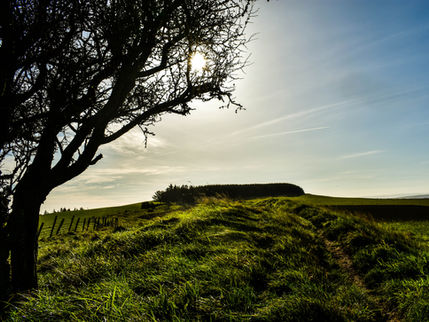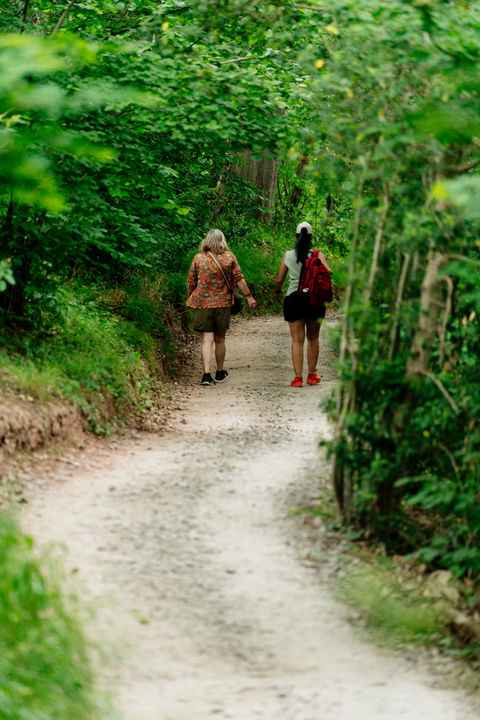
Hay On Wye
Books – and a celebrated summer festival – have put little ol’ Hay on the world map. Straddling the border between Wales and England, this town of just 2,000 inhabitants is a genuine one-off. It’s worth taking a look between its covers – you’ll find more than just books.
Here’s what you can buy in Hay-on-Wye: wheelbarrows, chandeliers, old maps, faux Louis XV furniture, fertiliser, vintage clothes, ‘60s LPs, stuffed animals, art (all sorts), in-vogue fashions, wellies, New Age crystals, tin baths, tin cars, rocking horses, rucksacks, ceramics, antique bikes, Barbour jackets, guitars, Welsh lavender (yes, it does exits) … oh, and books.
We forgot to mention books. How could we, in the place that bills itself as ‘The first book town in the world’?
Hay 2.0
Hay has to be one of the world’s best exemplars in how to reinvent yourself. Before Richard Booth (more on him later) came on the scene in the 1960s, Hay-on-Wye was a sleepy rural backwater where farmers from the wild, woolly Black Mountains and not-so-wild lush border country used to congregate for a spot of shopping and sheep-dealing.
Nowadays, the currency is measured in books, plus the wares of a kaleidoscope of retailers (those wheelbarrow- and chandelier-sellers, etc) who have grabbed onto the booksellers’ coat-tails and set up shop. We should also mention that independence rules the day here: there’s not a chain in sight.
Here’s a challenge: try counting the number of shops and galleries in Hay. You’ll soon be bamboozled. And here’s the acid test: come to Hay on a wet Sunday in deep, dark December, when the rest of rural Wales is soundly asleep, and you’ll find many of those shopkeepers bright-eyed and open for business. Nowadays, perennial buzz and business define this once-drowsy town.
The King of Hay
The town really is remarkable. Its ascent began in the 1960s when Richard Booth, the epitome of eccentricity and self-publicity, arrived on the scene, opened his second-hand bookshop, ensconced himself in the crumbing splendour of Hay Castle, and declared Hay an independent state with its own king (him, obviously).
Booth died in 2019, but his name lives on at his eponymous bookshop, housed in a suitably characterful black-and-white building on Lion Street in the centre of town. It’s impossible here to mention every bookshop since they’re so thick on the ground – even the former fire station (Booth’s first bookshop) and old cinema (also owned by the bibliophile magnate) have a new lease of life selling books.
In Booth’s considerable wake, other booksellers arrived. Today, almost every other shop sells books, not just dog-eared second-hand books but valuable first editions, new books, antiquarian books, novels by Victorian writers and the latest hot authors, books for children, books on warfare, crime, transport, astrophysics, folklore, crochet for beginners and every other subject under the sun.
Woodstock in Wales
And, of course, the town plays host every early summer to the world-famous Hay Festival (Bill Clinton’s ‘Woodstock of the mind’), a glittering literary occasion that attracts not just superstar authors but also agenda-setting politicians, scientists, celebrities and journalists… and, it seems, every single member of London’s glitterati.
Hay is a very festive place in summer. Around the same time as the Hay Festival there’s also the HowTheLightGetsin Festival. Run by the Institute of Arts and Ideas, it’s billed as ‘the world’s largest philosophy and music festival, where ideas are born and the imagination is set free’.
You sometimes wonder how they manage to squeeze all those shops (and people, on busy weekends) into Hay. It’s not a big place. Castle Street, running along a ridge beside (you’ve guessed it) Hay Castle, leads to the town’s charming focal point, the covered Butter Market. Go down the hill and you’ll find yet more shops and something else the town isn’t short of – cafés, restaurants and pubs.
Come on a Thursday for the full-fat market day experience. A little further from the town centre there’s The Globe at Hay, an independent arts centre that hosts live music, plays and exhibitions.
Where’s the Wye?
The big puzzle is the river. Where is it? It’s hidden away beyond the shops, but well worth seeking out. Find the bridge across the Wye then follow the footpath – it tracks the old railway line – beside the lazy Wye and its rich rivermeadows, then turn back into the town to complete a rewarding walk that’s the perfect antidote to Hay’s excess of retail therapy.
On the way back into town you’ll pass the scant ruins of a rudimentary motte-and-bailey castle, next to St Mary’s Church, built by the Normans. But the stronghold they’re now all talking about is Hay Castle, which looms above the entire town. Also of Norman origin, it was built by William de Breos II, a notorious, all-powerful Marcher lord remembered for his treacherous deeds. In later life the castle evolved into a Jacobean mansion, which suffered fire damage in 1939 and 1977.
A castle reborn
Until recently it was in a sorry state. Following a major £5½ million restoration project, it has reopened as a new centre for arts, culture and learning, mirroring Hay’s reinvention as a town. You never know, it might even sell a book or two.

CURIOSITIES AND SURPRISES
-
What’s in a name? The town was originally known as ‘The Hay’, a name deriving from the Norman ‘Hay’ or ‘Haie’ meaning a fenced or hedged enclosure. Hay’s Welsh name, Y Gelli, means grove.
-
A world-famous festival. Hay Festival has attracted enough awards to fill a book. The New York Times, for example, called it ‘the most prestigious Festival in the English-speaking world’. Not that its fame is confined to an anglophone audience. Spin-off versions now take place in Spain, Mexico, Colombia and Peru. And, like Redu in Belgium and Timbuktu in Mali, Hay is now an official book town.
-
Out for the count. Bookshops come and bookshops go in Hay, but in any one time there are more than 20, including some that have been there right from the start. No one really knows how many books are in circulation in a town of just 1,500 inhabitants. Estimates range from over a million to 10 million. To count them all would be an auditor’s worse nightmare.
-
Lady of Hay. That’s the title of a best-selling novel by Barbara Erskine, translated into 17 languages, that tells the tale of a contemporary woman who discovers her past life as a 12th-century Welsh noblewoman from Hay.
-
Drinking companions. The Grade II listed Three Tuns pub and restaurant is reputedly the oldest surviving house in Hay, dating from the 16th century. It’s had a few famous – perhaps we should make that infamous – customers in its time, including some of the Great Train Robbers and, less controversially, Marianne Faithful and Jools Holland.
-
Only joking… or am I? When Richard Booth declared independence for Hay on 1 April 1977 he was crowned king and appointed his horse as prime minister.



A DAY IN THE LIFE
You’ll be kept busy in Hay. Here are a few things you won’t want to miss. While you don’t have to visit them in the order below, we’ve laid them out in a way that will help you make the best of your time in town. And if you only have half a day or less to spend, simply pick the places that spark your curiosity – and come back some other time for the complete Hay experience.
Hay Butter Market
This delightful centrepiece to the town is a good place to start. Built in 1830 by William Enoch, a local entrepreneur, and surrounded by shops of all descriptions, it’s always alive with activity. This covered market area replaced an old open market for use by local traders and farmers on market days. It still serves this purpose every Thursday (and also some Saturdays) when you can peruse stalls selling a mix of arts, crafts, local produce, old records and (inevitably) books.
Hay Castle
Soaring above the Butter Market and centre of town are the walls of Hay Castle. It’s more house than castle – a Jacobean mansion, no less, built between 1600 and 1650 on the site of a Norman Marcher fortification dating from around 1200 that saw active service in these troubled borderlands throughout the medieval period, suffering attack and defence, destruction and repair.
Talking of repair, the neglected mansion has now acquired a new lease of life as a centre for arts, culture and learning with a gallery, café and shops, all thanks to a £5½ million restoration programme. It hosts events throughout the year from highbrow (literature) to lowbrow (unashamed family-fun activities). You can also take a guided tour, and there’s a chance to become your own lord or lady in the manner of the late, self-appointed ‘King of Hay’, Richard Booth (the castle is entitled to bestow its own ‘peerages’, a dubious tradition not to be taken too seriously, dating back to 1977 when Booth declared Hay an independent kingdom).
Bookshops
You won’t want much help in finding these. But, be warned, they can soak up your entire day – and more. Some bibliophiles have been known to enter Hay’s bookish black hole never to be seen again.
You’ll find bookshops on every street, up every nook and cranny. They’re big (dauntingly big in some cases, with miles of shelves and an overwhelming choice of titles) and quite tiny, specialising in specific genres. You’ll come across books of all shapes and sizes, old books and new books, valuable first-editions and scruffy paperbacks.
The Globe at Hay
Billed as an independent ‘institute of art and ideas’ and based at a beautifully converted Georgian chapel dating from 1752, The Globe is a charming little venue for live theatre and music, open mic nights and poetry readings (there’s also a gallery space and café/bar/restaurant).
Riverside walk
Had your fill of books, cafés and shops? Then discover the Wye in Hay-on-Wye. To find this reclusive river (you won’t see it from town) make for the bridge (where Bridge Street meets Broad Street) and pick up the Wye Valley Walk. It’s a peaceful riverside stroll southward that follows the old railway line from Brecon to Hereford.
Look out for the wooden sculptures of local wildlife hidden amongst the trees and shrubs. It’s a shortish walk – in around one-third of a mile/550m from the start of the riverside trail take the path uphill that leads to St Mary’s Church. On the way back into the hustle and bustle of Hay you’ll also pass the scant ruins of a primitive motte and bailey castle, Hay’s original fortification dating from around the early 1100s.
Hay Craft Centre
Unlike Hay’s traditional town centre, the Craft Centre – next to the main car park – is a modern purpose-built complex. There’s an eclectic mix of shops – galleries, jewellery, gifts, woodcarvings and the like – with (strangely) not a book in sight. Across the road you’ll find a small local tourist information centre.















